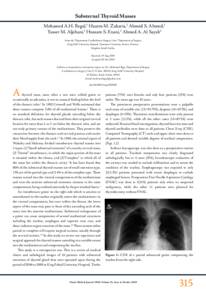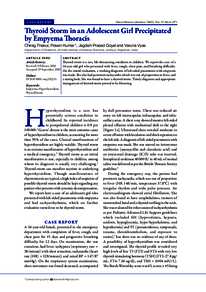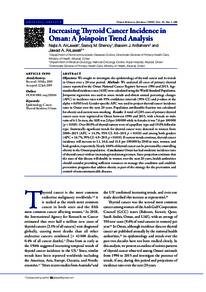Document
Substernal thyroid masses.
Contributors
Zakaria, Hazem M., Author
Ahmed, Ahmed S., Author
Al-Jehani, Yasser M., Author
Enani, Hussam S., Author
Al-Sayah, Ahmed A., Author
Gregorian
2010-10
Language
English
Subject
English abstract
A thyroid mass, most often a non toxic colloid goiter or occasionally an adenoma, is not an unusual finding below the level of the thoracic inlet.1 In 1992 Creswell and Wells estimated that these tumors comprise 5.8% of all mediastinal lesions.1 There is no standard definition for thyroid glands extending below the thoracic inlet, but such masses descend from their original cervical location for more than 2 or 3 cm below the thoracic inlet, and are not truly primary tumors of the mediastinum. They preserve the connection between the thoracic and cervical portion and receive their blood supply from the neck.2,3 In 1940, the seminal report of Wakeley and Mulvany divided intrathoracic thyroid masses into 3 types; (1)"Small substernal extension" of a mainly cervical mass, (2) "Partial" intrathoracic, in which the major portion of the mass is situated within the thorax, and (3)"Complete" in which the major portion of the mass is situated within the thorax, and (3)"Complete" in which all of the mass lies within the thoracic cavity.1 It has been found that 80% of the substernal thyroid masses are of small extension type, 15% are of the partial type and 2-4% is of the complete type. These masses extend into the visceral compartment of the mediastinum and even the anterior substernal extension remains in the same compartment, being confined anteriorly by the pre-tracheal fascia.1 An intrathoracic goiter on the right side which is anterior or anterolateral to the trachea originally enters the mediastinum via the visceral compartment, but once within the thorax, the lower aspect of the mass may pass in front of the ascending arch of the aorta into the anterior mediastinum.
Member of
Resource URL
Category
Journal articles



